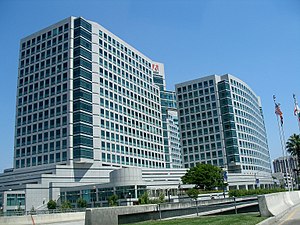Table of Contents
strong>Adobe Photoshop, or simply Photoshop, is a graphics editing program developed and published by Adobe Systems.
It is the current market leader for commercial bitmap and image manipulation software, and is the flagship product of Adobe Systems. It has been described as “an industry standard for graphics professionals and was one of the early “killer applications” on the Macintosh, later also for the PC.

Adobe’s 2005 “Creative Suite” rebranding led to Adobe Photoshop 8’s renaming to Adobe Photoshop CS. Thus, Adobe Photoshop CS4 is the 11th major release of Adobe Photoshop. The CS rebranding also resulted in Adobe offering numerous software packages containing multiple Adobe programs for a reduced price. Adobe Photoshop is included in most of Adobe’s Creative Suite offerings.
Photoshop’s popularity, combined with its high retail price, makes Photoshop’s piracy rate relatively high.Adobe countered by including SafeCast DRM starting with Adobe Photoshop CS.
Early history
In 1987, Thomas Knoll, a PhD student at the University of Michigan, began writing a program on his Macintosh Plus to display grayscale images on a monochrome display. This program, called Display, caught the attention of his brother John Knoll, an Industrial Light & Magicemployee, who recommended Thomas turn it into a full-fledged image editing program. Thomas took a six month break from his studies in 1988 to collaborate with his brother on the program, which had been renamed ImagePro.Later that year, Thomas renamed his program Photoshop and worked out a short-term deal with scanner manufacturer Barneyscan to distribute copies of the program with a slide scanner; a “total of about 200 copies of Photoshop were shipped” this way.
During this time, John traveled to Silicon Valley and gave a demonstration of the program to engineers at Apple and Russell Brown, art director at Adobe. Both showings were successful, and Adobe decided to purchase the license to distribute in September 1988. While John worked on plug-ins in California, Thomas remained in Ann Arbor writing program code. Photoshop 1.0 was released in 1990 for Macintosh exclusively.
Features
Photoshop has strong ties with other Adobe software for media editing, animation, and authoring. The .PSD (Photoshop Document), Photoshop’s native format, stores an image with support for most imaging options available in Photoshop. These include layers with masks, color spaces, ICC profiles, transparency, text, alpha channels and spot colors, clipping paths, and duotone settings. This is in contrast to many other file formats (e.g. .EPS or .GIF) that restrict content to provide streamlined, predictable functionality.
Photoshop’s popularity means that the .PSD format is widely used, and it is supported to some extent by most competing software. The .PSD file format can be exported to and from Adobe Illustrator, Adobe Premiere Pro, and After Effects, to make professional standard DVDs and provide non-linear editing and special effects services, such as backgrounds, textures, and so on, for television, film, and the Web. Photoshop is a pixel-based image editor, unlike Macromedia FreeHand (now defunct), Adobe Illustrator or CorelDraw, which are vector-based image editors.
Photoshop can utilize the color models RGB, lab, CMYK, grayscale, binary bitmap, and duotone. Photoshop has the ability to read and write raster and vector image formats such as.EPS, .PNG, .GIF, .JPEG, and Adobe Fireworks.
CS3

Smart Layers display the filter without altering the original image (here on Mac OS X)
Photoshop CS3 is marketed with three main components of improvement over previous versions: “Work more productively, edit with unrivalled power, and composite with breakthrough tools.” New features propagating productivity include streamlined interface, improved Camera Raw, better control over print options, enhanced PDF support, and better management with Adobe Bridge. Editing tools new to CS3 are the Clone Source palette and nondestructive Smart Filters, and other features such as the Brightness/Contrast adjustment and Vanishing Point module were enhanced. The Black and White adjustment option improves users control over manual grayscale conversions with a dialog box similar to that of Channel Mixer. Compositing is assisted with Photoshop’s new Quick Selection and Refine Edge tools and improved image stitching technology.
CS3 Extended contains all features of CS3 plus tools for editing and importing some 3D graphics file formats, enhancing video, and comprehensive image analysis tools, utilizing MATLAB integration and DICOM file support.
CS4
Photoshop CS4 features additions such as the ability to paint directly on 3D models, wrap 2D images around 3D shapes, convert gradient maps to 3D objects, add depth to layers and text, get print-quality output with the new ray-tracing rendering engine, and enjoy exporting to supported common 3D formats; the new Adjustment and Mask Panels; Content-aware scaling (also known as seam carving); Fluid Canvas Rotation and File display options.On 30 April, Adobe released Photoshop CS4 Extended, which includes all the same features of Adobe Photoshop CS4 with the addition of capabilities for scientific imaging, 3D, and high end film and video users. The successor to Photoshop CS3, Photoshop CS4 is the first 64-bit Photoshop on consumer computers (only on Windows the OS X version is still 32-bit only.)
Language availability
Photoshop is available in the following languages:
Brazilian Portuguese, Chinese Simplified, Chinese Traditional, Czech, Danish, Dutch, English, Finnish, French, German, Hungarian, Italian, Japanese, Korean, Norwegian, Polish, Romanian, Russian, Spanish, Swedish, Turkish and Ukrainian.
The Arabic, Greek, Hebrew, Middle Eastern, and North African language versions are available from Winsoft.




UI/UX Consultant, Photoshop, XD, SketchApp, Product Designer, Website Designer, Mobile App Designer, Expert WordPress Developer. For web/mobile design and wordpress development related projects please contact me at dibakar@themepurpose.com



